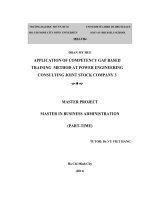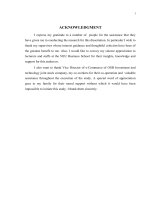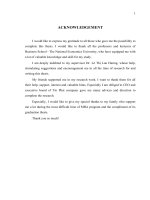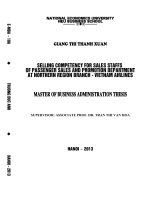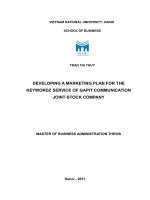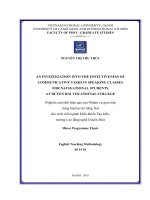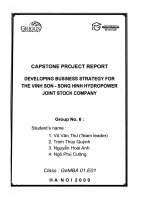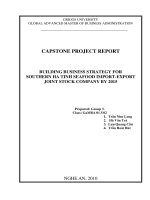Creating work motivation for sales staffs at truong hai automobile joint stock company
Bạn đang xem bản rút gọn của tài liệu. Xem và tải ngay bản đầy đủ của tài liệu tại đây (1.35 MB, 92 trang )
ĐẠI HỌC QUỐC GIA HÀ NỘI
KHOA QUẢN TRỊ VÀ KINH DOANH
---------------------
NGÔ THỊ HIỀN
CREATING WORK MOTIVATION FOR SALES STAFFS AT
TRUONG HAI AUTOMOBILE JOINT STOCK COMPANY
TẠO ĐỘNG LỰC LÀM VIỆC CHO NHÂN VIÊN KINH DOANH
TẠI CÔNG TY CỔ PHẦN Ô TÔ TRƯỜNG HẢI
LUẬN VĂN THẠC SĨ QUẢN TRỊ KINH DOANH
HÀ NỘI - 2019
ĐẠI HỌC QUỐC GIA HÀ NỘI
KHOA QUẢN TRỊ VÀ KINH DOANH
---------------------
NGÔ THỊ HIỀN
CREATING WORK MOTIVATION FOR SALES STAFFS AT
TRUONG HAI AUTOMOBILE JOINT STOCK COMPANY
TẠO ĐỘNG LỰC LÀM VIỆC CHO NHÂN VIÊN KINH DOANH
TẠI CÔNG TY CỔ PHẦN Ô TÔ TRƯỜNG HẢI
Chuyên ngành: Quản trị kinh doanh
Mã số: 60 34 01 02
LUẬN VĂN THẠC SĨ QUẢN TRỊ KINH DOANH
NGƯỜI HƯỚNG DẪN KHOA HỌC: PGS.TS. NGUYỄN NGỌC THẮNG
HÀ NỘI - 2019
DECLARATION
The author confirms that the research outcome in the thesis is the result of
author’s independent work during study and research period and it is not yet
published in other’s research and article.
The other’s research result and documentation (extraction, table, figure,
formula,
and other document) used in the thesis are cited properly and the
permission (if required) is given.
The author is responsible in front of the Thesis Assessment Committee,
Hanoi School of Business and Management, and the laws for above-mentioned
declaration.
Date…………………………..
LỜI CẢM ƠN
I would like to express my deep gratitude to the Associate Professor - Dr
Nguyen Ngoc Thang, who kindly guided and instructed me during the research and
completion of this thesis.
Thank you very much to all the Hanoi school of Business and Management,
Vietnam National University, Hanoi for their dedicated teaching and knowledge
transfer during the MBA course.
Thank you sincerely to all colleagues, business staff, managers at Truong Hai
Automobile Joint Stock Company for facilitating and supporting me in the process
of collecting research data.
Wishing you all teachers, all your brothers and sisters with lots of health, lots
of success in work and in life.
Sincerely thank!
Date…………………………..
Ngô Thị Hiền
TABLE OF CONTENTS
LIST OF TABLE....................................................................................................... i
LIST OF FIGURE.................................................................................................... ii
INTRODUCTION .....................................................................................................1
CHAPTER 1: THEORY FRAMEWORK ON WORK MOTIVATION,
FACTORS AFFECTING THE EMPLOYEES’ WORK MOTIVATION ..........9
1.1. Concepts on work motivation ...........................................................................9
1.2. Concept on work motivation: ............................................................................9
1.3 Necessity of motivating employees...................................................................10
1.4Work motivation-related theories ....................................................................11
1.4.1 Abraham Maslow's need theory ...................................................................11
1.4.2 F. Herzberg's two-factor theory ....................................................................12
1.4.3 Skinner's Reinforcement Theory of Motivation ...........................................14
1.4.4 John Stacey Adams' equity theory ................................................................14
1.5 Factors affecting the employees’ work motivation ........................................16
1.5.1 Job attractiveness ..........................................................................................16
1.5.2 Promotion opportunities and training ...........................................................16
1.5.3 Work relationship .........................................................................................17
1.5.4 Income ..........................................................................................................17
1.5.6 Award and recognition policy ......................................................................20
1.5.7 Working environment ...................................................................................20
1.5.8 Brand and corporate culture..........................................................................20
1.5.9 Leaderships style ..........................................................................................21
1.6 Some enterprises’ experience in work motivation and lesson for Truong
Hai Automobile Joint Stock Company ..................................................................22
1.6.1. Experience of Sai Gon Mechanical Electrical Joint Stock Company .........22
1.6.2 Experience of Coca-Cola Beverages Vietnam Limited ................................23
1.6.3 Lesson for Truong Hai Automobile Joint Stock Company ..........................24
CHAPTER 2: RESEARCH METHODOLOGY .................................................26
2.1 Research methodology ......................................................................................26
2.1.1 Questionnaire survey method .......................................................................26
2.1.2 Questionnaire design ....................................................................................26
2.1.3 Survey and data collection ............................................................................27
2.1.4 Interview method ..........................................................................................27
2.1.5 Data processing method ................................................................................27
2.2 Research process ...............................................................................................27
2.3 Study assumption ..............................................................................................27
2.4 Scale design ........................................................................................................28
CHAPTER 3: EXISTING STATUS OF MOTIVATING SALE STAFF IN
TRUONG HAI AUTOMOBILE JOINT STOCK COMPANY; MAIN
FINDINGS ...............................................................................................................35
3.1 Introduce of Truong Hai Auto Corporation...................................................35
3.1.1 Overview of Truong Hai Auto Corporation .................................................35
3.1.2 Development process ....................................................................................35
3.1.3 Vision ............................................................................................................36
3.1.4 Mission..........................................................................................................36
3.1.5 Development strategy milestones .................................................................36
3.1.6 Business philosophy .....................................................................................37
3.1.7 Business model .............................................................................................38
3.1.8 Organizational structure................................................................................39
3.1.9 Business performance results .......................................................................40
3.2 Existing status on work motivation of sale staff .............................................41
3.2.1 Salary and salary-based allowances..............................................................41
3.2.2 Bonus salary..................................................................................................43
3.2.3 Treatment and welfare regulations ...............................................................44
3.2.4 Training .........................................................................................................47
3.2.5 Promotion opportunities ...............................................................................48
3.2.6 Working environment and corporate culture ................................................49
3.2.7 Work relationship .........................................................................................50
3.3 Main findings .....................................................................................................50
3.3.1 Gender characteristics ...................................................................................50
3.3.2 Age characteristics ........................................................................................51
3.3.3 Qualification characteristics .........................................................................51
3.3.4 Service length characteristics .......................................................................52
3.3.5 Income characteristics ..................................................................................52
3.3.6 Statistics of factors affecting the work motivation .......................................53
3.4 Contributions of the study ................................................................................63
CHAPTER 4 ............................................................................................................65
RECOMMENDATIONS ON IMPROVING WORK MOTIVATION FOR
SALE STAFFS AT TRUONG HAI AUTOMOBILE JOINT STOCK
COMPANY ..............................................................................................................65
4.1 Income and welfare ...........................................................................................65
4.1.1 Income ..........................................................................................................65
4.1.2 Welfare..........................................................................................................67
4.2 Award and recognition policy ..........................................................................67
4.3 Job attractiveness ..............................................................................................68
4.4 Promotion opportunities and training ............................................................68
4.5 Leadership style .................................................................................................69
CONCLUSIONS .....................................................................................................70
LIST OF REFERENCES .......................................................................................72
LIST OF TABLE
Table 2.1: Personal data ............................................................................................29
Table 2.2: Job attractiveness scale ............................................................................29
Table 2.3: Promotion opportunities and training scale .............................................30
Table 2.4: Work relationship scale............................................................................30
Table 2.5: Income and welfare scale .........................................................................31
Table 2.6: Award and recognition policy scale.........................................................31
Table 2.7: Working environment scale .....................................................................32
Table 2.8: Brand and corporate culture scale ............................................................32
Table 2.9: Leadership style scale ..............................................................................33
Table 2.10: Employees’ work motivation scale ........................................................34
Table 3.1: Sale staff’s evaluation on job attractiveness ............................................53
Table 3.2: Sale staff’s evaluation on promotion opportunities and training .............54
Table 3.3: Sale staff’s evaluation on work relationship ............................................55
Table 3.4: Sale staff’s evaluation on income and welfare ........................................56
Table 3.5: Sale staff’s evaluation on award and recognition policy .........................57
Table 3.6: Sale staff’s evaluation on working environment .....................................58
Table 3.7: Sale staff’s evaluation on brand and corporate culture ............................59
Table 3.8: Sale staff’s evaluation on leadership style ...............................................60
Table 3.9: Work motivation and working attitude of employees .............................62
Table 4.1: KPI for evaluating sales activities ...........................................................66
i
LIST OF FIGURE
Figure 1.1: Maslow’s hierarchy of needs ..................................................................11
Figure 1.2 Two-factor theory ....................................................................................13
Figure 2.1: Survey and investigation procedure .......................................................26
Figure 2.2: Factors affecting the employees’ work motivation ................................28
Figure 3.1: Labor structure by gender of sale staff ...................................................50
Figure 3.2: Labor structure by age of sale staff ........................................................51
Figure 3.3: Labor structure by qualification .............................................................51
Figure 3.4: Labor structure by service length ...........................................................52
Figure 3.5: Labor structure by income ......................................................................52
ii
INTRODUCTION
1. Rationale
Human resources are always the most valuable asset of each enterprise. In
the globalization and economic integration trend, the competitive environment
among enterprises has become increasingly severe, requiring enterprises to pay
attention to building, developing and training human resources in order to improve
their qualification and bring about high work efficiency. Work motivation is one of
the key determinants of human resources development in every enterprise. When
the enterprise creates high work motivation for staffs, they will be passionate,
inquisitive, creative and willing to contribute to the Enterprise. On the contrary, if
they do not have motivation, they will work with a modest attitude and not show
their maximum ability, leading to lower work efficiency and affecting the overall
goal of the Enterprise.
In fact, Enterprises have been creating different work motivations for
employees. However, there are still many inadequacies and their working
conditions have not satisfied the requirements of employees, the welfare system is
not satisfactory and the working environment is still limited. Enterprises attach
importance to profits and development objectives but they neglect to encouraging
and motivating employees to work and devote all their abilities and capabilities to
work for the development goals of the Enterprise.
Truong Hai Automobile Joint Stock Company is a leading corporation in
Vietnam specializing in manufacturing, assembling and distributing coaches, trucks,
buses and also the Number 1 enterprise among Top 500 largest enterprises in
Vietnam in 2017. In the current automobile market with increasingly fierce
competition between car manufacturers to achieve sales targets, in addition to
building and expanding the sales system nationwide, improving the quality of
products and services, the car manufacturers also pay attention to reward and
welfare policy; training and development of staffs. Truong Hai Automobile Joint
Stock Company has also paid much attention to building, training and changing
1
many policies, reward regimes and benefits to encourage, develop and retain sales
staffs for 3 recent years. However, the sales staffs’ resignation rate is still quite
high, up to 40% per year. In the above situation, I decided to choose the theme
“Creating work motivation for Sales staffs at Truong Hai Automobile Joint stock
company” with the desire to create higher motivation for its employees and help it
grow drastically and achieve its strategic objectives in business activities.
2. Literature review
Creating work motivation for staffs is one of the factors that have a great
impact on the work efficiency as well as the achievement of the goals of an
enterprise. Motivated employees will be aware of the work they are doing, work
hard, love their job and commit to working for the enterprise in a long-term,
constantly strive to study and improve their skills, research and find out the ways to
do work effectively.
The world’s famous motivation doctrines are:
- Abraham Maslow’s demand theory
- Frederick Herzberg’s two elements theory
- Victo Vroom’s expectation theory
- Stacy Adam’s Justice Theory
These doctrines have been applied in many areas of social life from
economics, military, medicine and many other fields.
In Vietnam, there are also many monographs, research works, dissertations,
scientific articles on work motivation creation such as:
Nguyen Van Diem, Nguyen Ngoc Quan (2015), “Human Resources
Management” Textbook, Hanoi National Economics University Publishing House.
The textbook gives an overview of human resources management; human resource
planning and arrangement; work motivation creation; development and evaluation
of human resources; remuneration and benefits; wage and salary management;
financial incentives; labor relations; safety and health for workers.
Le Thanh Ha, Nguyen Thi Hong, Nguyen Ba Ngoc, Pham Ngoc Thanh
(2012), “Human Resources Management” textbook, Hanoi University of Labor and
2
Social affairs Publishing House. The textbook covers the basic issues of human
resources use, work motivation creation, human resources training and
development. Remuneration and welfare for employees and the contents of labor
relations in the organization.
Vu Thi Uyen (2008), “Creating motivation for managers in state-owned
enterprises in Hanoi until 2020” PhD dissertation, National Economics University.
The dissertation emphasized the role of managers in the enterprise and motivation
creation for managers; Analyzed the current status of motivation creation for
managers in some enterprises in Hanoi City; thereby giving some solutions to
motivate managers in enterprises.”
Nguyen Thi Phuong Lan (2015), “Improving the motivation creation tools
for civil servants in state administrative agencies”, PhD dissertation in Public
Management, National Academy of Public Administration. The dissertation has
studied the published scientific works related to motivation creation for staffs in
organizations in general and civil servants in the State administrative agencies
(SAA) in particular; analyzed and evaluated these scientific works to point out the
strengths, weaknesses and gaps in research to build the scientific bases for the
theme; researched the current status of work motivation creation for civil servants in
the State administrative agencies in Vietnam from 2001 to present; Proposed
solutions to improve the work motivation creation tools system for civil servants in
the State administrative agencies.
Nguyen Thi Phuong Dung (2016), “Work motivation of office staffs in
Vietnam”, PhD dissertation, University of Economics, Ho Chi Minh City. The
author has discovered and measured the factors that make up work motivation of
office staffs in Vietnam; Determined the impact of the staffs’ perceptions and
beliefs in the organizations and informal relationships at the workplace on work
motivation; Developed and tested a theoretical model of the relationship between
work motivation and behavioral outcomes based on the social context in Vietnam;
Verified the difference in work motivation based on personal characteristics,
geographic location and working area. The test results of the theoretical model
3
showed that belief in an organization has a very great influence on the behavioral
outcomes of employees. In addition, the research also indicated that personal
relationships altered the relationship between organizational beliefs and work
motivation of employees. It not only impacted directly behavioral outcomes but also
indirectly through motivation. Meanwhile, the previous research suggests that
financial rewards are an important factor motivating employees to work. This
finding contributes to and brings about a new view of scientific theory that not only
financial policy but also other factors such as employee’s belief in the organization
play an important role in creating their work motivation.
Some scientific articles:
Truong Minh Duc, Application of the quantitative model to assess work
motivation creation for employees of ERICSSON Limited Liability Company in
Vietnam, Science Journal, Vietnam National University, Hanoi- University of
Economics and Business dated July 02, 2011. The author shows that the effective
management and use of labors is always a top concern of Vietnamese enterprises at
present. The recruitment and arrangement of the right people and the right work is
very important but encouraging, motivating and creating work motivation for
employees to maximize their intellectual ability is the most critical issue in the use
of labors. To motivate employees, managers need to understand their work needs,
for what they do work, what motivates them to work hard, thereby finding out the
appropriate ways. The articles focuses on four key issues: (i) the theoretical issues
of motivation creation, (ii) the research methods for the practical problems of the
enterprise, (iii) the regression model survey and (iv) the conclusions and
recommendations. By applying Maslow’s five needs theory to assess motivation
creation for staffs in the Company, the author built the application model.
Ngo Hai Anh, some motivational factors for lecturers of Ho Chi Minh
National Academy of Politics, Journal of Political Theory dated July 26, 2016. The
author’s research briefly gives the concepts of motivation, motivation creation for
staffs in the organization as well as factors affecting motivation creation for staffs in
the organization. However, Ho Chi Minh National Academy of Politics is a highly
4
academic environment with high-quality human resources in society. The character
of this environment is training leaders and researchers of political theory, guidelines
and policies of the Party and the State. Lecturers and researchers are those who
directly teach and do scientific research. Thus, the author proposes a number of
motivational solutions for the workforce at the Academy with particular
characteristics. To create motivation, the following factors should be considered:
income, work, working environment, promotion; for example, for the Academy’s
environment, the development of qualifications (academic titles, degrees), the
lecturers’ scientific capacities. Therefore, it is necessary to create favorable
conditions in terms of mechanisms and policies for lecturers and scientists to
improve professional qualifications in research.
Generally, the researches and articles on work motivation creation refer only
to the most common issues or to one aspect of the issue. Some macro-level studies
have a wide range of one industry. Some researches focus on one or more tools or
factors that influence motivation of staffs. There are also some researches into
creating motivation for civil servants in state agencies in different professions such
as lecturers and state enterprises.
In different organizations, motivational tools for employees are also
influenced by factors inside and outside the organization. Besides, there are
currently no researches into creating work motivation for staffs at Truong Hai
Automobile Joint Stock Company. On that basis, the thesis will inherit the
achievements of the previous researches and focus on this work to apply directly to
Truong Hai Automobile Joint Stock Company. Therefore, the study into “Creating
work motivation for sales staff at Truong Hai Automobile Joint Stock Company” is
necessary and doesn’t completely coincide with the published researches.
3. Research objectives
- Systematize the basic issues of motivation and motivation creation for
employees
- Study the factors influencing the work motivation creation for employees
5
- Analyze and assesse the current status of creating work motivation for sales
staffs at Truong Hai Automobile Joint Stock Company
- Identify the factors that affect the work motivation of sales staff at Truong
Hai Automobile Joint Stock Company
- Propose solutions and recommendations to increase work motivation for
staffs and bring efficiency to the Company in the next time.
4. Research objects
- Research objectives: Work motivation of sales staffs at Truong Hai
Automobile Joint Stock Company
- Research subjects: Sales staffs who have been working at Truong Hai
Automobile Joint Stock Company
5. Research scope
- Spatial scope: Due to the limited time, the research is conducted in Hanoi City
- Time limit:
+ Secondary data: from 2014 to 2017
+ Primary data: investigation, survey from June 2018 to July 2018
6. Research methods
6.1 Theory research
Using the methods of analyzing, synthesizing, systematizing materials
directly or directly related to motivation and motivation creation to find out the
basic materials for forming the theoretical frameworks, theoretical points,
arguments and making the conclusions about the research issue.
6.2 Practice research
6.2.1 Questionnaire
The purpose of this method is to collect feedback on work motivation
creation for the sales staff and find out the reasons why they quit job
After the questionnaire is designed. A pilot interview is conducted with 10
sales staff to have the basis for adjusting the questionnaire accordingly and
improving the questionnaire before conducting an official investigation on sales
staffs who have been working at the company. The questionnaire is designed on the
6
basis of focusing on the factors that influence work motivation and job satisfaction,
including salary, bonus, welfare, working environment, training and development
opportunity.
Number of questionnaires: 150
Conduction time: from 6/2018 to 7/2018
Quantitative results from the questionnaire survey are used as the basis for
analyzing and evaluating the work motivation of sales staff in the company.
6.2.2 Interview
The interviews are conducted with two subjects who is a resigned sales staffs
and a sales staffs working for the Company to clarify what the questionnaire did not
fully reflect as the basis for demonstrating the quantitative data obtained
6.3.3. Methods for collecting and processing information
Secondary information and data:
+ Statistics reported from departments of Truong Hai Auto Joint Stock Company
+ Methods of analysis synthesized from textbooks, documents, master's theses,
doctoral theses, books, magazines and internet media.
Primary information and data:
Primary data is collected through questionnaires, consulted by officials and
employees who have been working at Truong Hai Automobile Joint Stock
Company, written by the author. The questionnaire is designed to include questions
directly related to the work of motivating employees. The questionnaire is divided
into 2 parts: Part 1 aims to identify some personal information for statistics by
gender, by age, by education level; Part 2 aims to collect ideas related to work
motivation for employees in the Company through 8 factors: attractiveness of work,
promotion and training, income and welfare, leadership style, corporate culture
brand, relationship in work, working environment, reward recognition.
Data processing methods:
Data collected will be classified, analyzed - synthesized; analysis - compare to
summarize results
7
The author uses the method of general analysis to generalize the theoretical content
related to research and give opinions and comments for this research.
The comparative method used by the author to clarify the difference of the object of
study between periods
Statistical methods are used to analyze data. The results were obtained from the
questionnaire, after being checked and cleaned, the data were transferred to Excel
software to synthesize, tabulate, graph and analyze information. The analytical
method is based on the percentage of each feedback on the given question. Thereby,
it is possible to evaluate the work of creating direct labor motivation of the
Company and thereby highlight the advantages and limitations, and propose
solutions to overcome limitations.
7. Expected design of the thesis
The thesis consists of 3 chapters:
Introduction: Rationale, literature review, research objectives, research
objects, research scope, research methods.
Chapter 1: Theory framework on work motivation, factors affecting the
employees’ work motivation
Chapter 2: Research Methodology
Chapter 3: Existing status of motivation sale staff in Truong Hai Automobile
Joint Stock Company; main findings
Chapter 4: Recommendations on improving work motivation for sales staffs
at Truong Hai Automobile Joint Stock Company
Conclusion: Conclusion
List of Tables
References
8
CHAPTER 1
THEORY FRAMEWORK ON WORK MOTIVATION, FACTORS
AFFECTING THE EMPLOYEES’ WORK MOTIVATION
1.1. Concepts on work motivation
Nguyen Van Diem, M.A and Assoc.Prof.Dr Nguyen Ngoc Quan shared that
“Work motivation is defined as the worker’s desire and willingness to improve
the efforts to fulfill the organization’s objectives.”
PhD Bui Anh Tuan from the National Economics University unveiled that:
“Work motivation is known as internal factors, motivating the persons to
actively work in the allowable context to generate high performance and
effectiveness.” Motivation is demonstrated by willingness, efforts and work
passion to fulfill the objectives of organization and individual”
Although a series of concepts on work motivation are available, the personal
internal factors are recognized as the key motivation. It includes the motivated
activities to impact the employee demand to facilitate their behavior changes
towards the objectives that are oriented by the enterprise. The work may be still
completed even when the employee is not motivated. However if the employee
is demotivated or not motivated, he shall loss his work performance capacity and
tend to far away from the organization.
In fact, how the motivation is created by which way is depended on specific
application regulation as a factor for the society development. If motivation is
created by benefits, it shall be impacted, excited and enhanced with effective
work performance, expertise or specific functions.
1.2. Concept on work motivation:
Work motivation refers to activities, (policies, measures, methods, etc.)
applied to the employee to motivate them to engage and implement the assigned
tasks with the highest performance to bring benefits for themselves and the
organization and enterprise. (Nguyen Van Diem, Nguyen Ngoc Quan, 2015)
9
Assoc.Prof.Dr Le Thanh Ha unveiled that: “Work motivating is defined as a
collection of measures and behaviors of organization and manager to create the
great desire and willingness for the employees to make them pay more efforts and
strive to fulfill the objectives set by the organization. Possible measures include
financial and non-financial levers and the organization’s behavior demonstrated in
such organization and how the employee is treated”.
Therefore, work motivation may refer to the manager’s application of a set of
management policies, measures and methods, affecting the employees to drive them
in the work and obtain a higher job satisfaction and wish to make more
contributions to the organizations and enterprises.
Work motivation is not inherent in each person. It is regularly varied. At this
point of time, the work motivation is high but relatively or surely unavailable in the
employee sometimes. In different status and circumstances, the work motivation
shall be differently developed. For this reason, the manager can intervene and
impact the employees to successfully drive their work efforts.
1.3 Necessity of motivating employees
Motivating employees is attached with extremely significant role and
recognized with high efficiency for the concerned employees, each enterprise and
the social benefits
For individuals:
Motivating helps the employees to perfect themselves and have more work
initiatives. When the employees are motivated, they shall make more efforts to
study and draw lesson to improve the knowledge. Motivating helps the employees
to work enthusiastically and devoted to their work, then they shall be more
associated, whole-hearted and devoted to the enterprise, offering more added values
and personal development opportunities.
For enterprise:
Motivating improves the organization’s productivity, business performance,
cost effectiveness and facilitates the corporate development. Moreover, motivating
10
creates the engagement between the employees and enterprise, retains and attracts
the talents, enhancing the enterprise’s competitiveness
For the society:
Work motivation is known as a pre-requisite to successfully improve the
personal productivity and organizational business performance, facilitating the
economy growth, civilized social development and political stability.
In short, work motivation for employees is put on the top priority for each
manager. It is not only a task but also obligation towards their employees.
1.4Work motivation-related theories
1.4.1 Abraham Maslow's need theory
The psychologist Abraham Maslow revealed that: The employees are
characterized by a trapezoid hierarchy of needs, concretely: physiological needs, safety
needs, love and belongingness needs, esteem needs and self-actualization needs.
Selfactualization
Esteem needs
Love and belongingness needs
Safety needs
Physiological needs
Figure 1.1: Maslow’s hierarchy of needs
(Source: Human resources management course books (2012) - Assoc.Prf. Le Thanh
Ha - Labor and Social Publisher)
Among five needs mentioned above, physiological needs are the most basic
needs of the human beings. The physiological needs include the most basic and
essential needs for the human survival. It includes needs of: eating, clothing,
accommodation, traveling and others.
11
Next is safety needs which are stable and reliable. Persons wish to be
protected against uncertainty or self-protection.
Love and belongingness needs are one of the senior needs of the human
beings. It includes communication and talking with other persons to demonstrate
and accept the feelings, caring, needs of sharing the love, etc.
The higher hierarchy is esteem needs In addition to the needs to
communicate and talk with other person, the persons also wish to be respected and
recognized with their social standing.
The highest hierarchy is self-actualization needs, self-development and selfaffirmation needs. The persons wish to realize their personal potential. They always
wish to be more perfect.
Maslow unveiled that: In principles, whenever needs among such needs are
satisfied, then the next needs shall become the most important one. Personal need
satisfaction is originated from the lowest needs. The top needs only appear when the
bottom needs are successfully satisfied. Need satisfaction is characterized by
bottom-to-top hierarchy. Although no needs are fully satisfied in practice, the
basically satisfied needs shall not motivate the person any more. That is why the
manager wants to motivate their employees. Firstly, the manager is required to
thoroughly understand where such employees stand in the hierarchy of needs, then
orient towards their need satisfaction so that the highest result may be obtained by
the motivation policy.
1.4.2 F. Herzberg's two-factor theory
Herzberg assumed that a personal relation with the job is the basic factor and
the job success may be decided by the personal attitude towards the job. Herzberg
thoroughly reviewed the question “What do you want from your job?” Satisfaction
and dissatisfaction factors were divided into two groups by Herzberg through his
study, concretely:
Group 1: Motivational factors include the key factors for job motivation and
satisfaction such as: recognition, sense of achievement, job nature, job
responsibility and promotion. When such factors are absent, the employees shall
12
demonstrate their dissatisfaction, laziness and ineffective working. Herzberg
assumed that such are “satisfactory factors” for the motivational factors. When such
factors are successfully satisfied, motivation shall be created, i.e., job satisfaction.
Second group: Hygiene factors include the external factors beyond the job,
required to maintain the effective working status and prevent the unexpected
outcomes incurred by the employees such as: Enterprise’s management policies and
regulations, job supervision, salary, interpersonal relationship, working condition,
position and stable job. There is a thing to be noted that even when such factors are
highly satisfied, no motivation can be made. However, when the hygiene factors are
not assured, the employees shall be bored, dissatisfied, and demotivated to work. It
is so-called as “dissatisfaction factors” that cannot release any job motivation as
Employees are
not dissatisfied
and still
demotivated
Encouragement
factor
Employees are
dissatisfied
and
demotivated
Maintenance
factor
what referred to by Herzberg.
Employees are
satisfied and
motivated
Figure 1.2 Two-factor theory
(Source: (Nguyen Van Diem, Nguyen Ngoc Quan, 2015)
Such theory helps the manager to know which factors causing dissatisfaction
for the employee and how to eliminate such factors. However when the
dissatisfaction factors are removed, it does not mean that the employees are
satisfied. If it is required to motivate and satisfy the employees, the manager shall
focus on hygiene factors such as success, recognition and duty assignment.
Therefore, the satisfaction reasons are originated from the job contents while the
dissatisfaction factors are derived from the working environment. That is why in
order to drive each employee; both working environment and job must be impacted
by the manager.
13
1.4.3 Skinner's Reinforcement Theory of Motivation
Skinner assumed that the bonus or punitive tools are used to enhance or
restrict the personal behaviors. Concretely:
Inherited behaviors tend to be repeated while the non-bonus or punitive
behaviors shall be gradually eliminated.
The closer the interval between the behavior and bonus and punishment
behavior is, the higher the behavior change impact shall be.
Punishment restricts the managers’ unexpected behaviors and possibly
causes negative enforcement (such as reaction of employees, etc.),
hence, it is less effective than the bonus.
Managers should apply various methods to award the employees. Criticism
must be personalized, constructive and integrated with praise or award.
It is found that in order to motivate the employees, the employees’ awareness
must be improved so that they may see that their personal efforts shall offer the
expected bonus. In order to do so, in addition to interwoven reward and punishment,
the manager must create a good working environment, making the employees to
satisfy with the current working status, satisfying with the support from the leaders
and colleagues, etc. Then, the employees shall be more trusted into their efforts,
managers and enthusiastic to work with high performance.
1.4.4 John Stacey Adams' equity theory
Adams’ theory assumed that the employees compare what they have spent on a
task (input) against those they have received from such task (output) (so-called as
personal equity) and then their input-output rate against input-output rate of other
persons (so-called as social equity). If their rate is equal to that of other persons,
equity status shall be available. If such rate is not equal, inequitable status shall be
found. When the inequitable conditions exist, the employees shall make great efforts
to correct it.
According to this theory, if the equity is created in the organization, the
interpersonal relationship shall be much more cemented to the organization, the
employees shall be motivated and satisfied, and then they shall be much more loyal
14
and strongly attached to the organization. Vice versa, when each individual feels that
what he contributes is bigger than that he receives; he is no longer enthusiastic and
devoted to the work. Then, each individual shall compare and evaluate his
contribution and devotion against his received treatment and bonus. Three cases may
be occurred as follows:
-
First: If the employees assume that they are not well treated and the
bonus is not deserved with their efforts, they shall be dissatisfied, resulting in the
fact that they shall not work with their highest capacity. In the serious case, they may
disturb or leave to find a new job.
-
Second: If the employees believe that they are well treated, the bonus and
treatment are deserved to their efforts, they shall maintain their productivity as before.
-
Third: If the employees recognize that the bonus and treatment are
higher than their expected things, they shall work in a a harder and more active
manner. In this case, however, they tend to reduce the bonus value, disregard the
bonus and such bonus shall be meaningless for the long run.
In order to create the equity in the organization, the leaders and managers are
required to consider and evaluate the equity between what each individual of the
organization contributes and his received outcomes and find out every possible
measure to balance it. Only when the equity is found by each individual, they shall
make great effort to work for the overall objectives of the organization.
Equity theory requires the balance between giving and receiving. The
“balanced benefits and obligations” principle must be respected in each agency and
organization. When the personal benefits are respected, a great motivation and
encouragement shall be created. Benefits must be equally distributed by capacity,
qualification, efforts, enthusiastic, hardworking, flexibility, personal sacrifice, loyalty,
work performance and efficiency, contributions to each organization. Benefits
received by each individual may be salary, bonus, welfare, favorable studying to
improve the qualifications, recognition or promotion, etc.
15
The equity theory requires the managers to pay special attention to the factors
governing the employees’ awareness on equity and influence to make the employees
have a sound awareness on equity.
In short: A series of motivation theories are developed for the employees,
revealing various motivation approaches. However, a common feature is shared by
such theories, concretely: Enhancing the employee motivation leads to increased
labor productivity and bigger victories for the organization. Therefore, the managers
must be more flexible in applying the theories to be well matched with their internal
conditions to obtain the best effectiveness, bringing the expected outcomes.
1.5 Factors affecting the employees’ work motivation
1.5.1 Job attractiveness
How do employees feel when they receive unexpected job? Vice versa, how
do they feel when an offered job is suitable with their capacity and hobbies? The
employees’ labor productivity and performance shall be significantly affected by such
issues. When a suitable job to be well matched with the employees’ capacity and
strength is offered, the employees shall maximize the job even in the most normal
status. Challenging jobs shall be a good opportunity for the employees. The
employees shall be more satisfied and contented when the corporate policies such as
salary, bonus, allowances and benefits are suitable with their demand. However, the
material demand is found in every employee. Some employees like money, but other
loves job freedom and traveling to many places, etc. Therefore, personal
characteristics must be considered to design the most feasible jobs for the employees.
1.5.2 Promotion opportunities and training
Training: refers to studying activities to help the employees to successfully
fulfill their assigned functions and missions. Such studying makes the employees to
master their assigned tasks. It includes the studying activities to improve the
employee qualification and skills to help them work in a more effective manner.
Promotion: refers to the movement to the important position or work in a
company. Promotion facilitates the personal development, enhances the prestige and
power of employees. Promotion policy means personal self-actualization. Promoted
16

